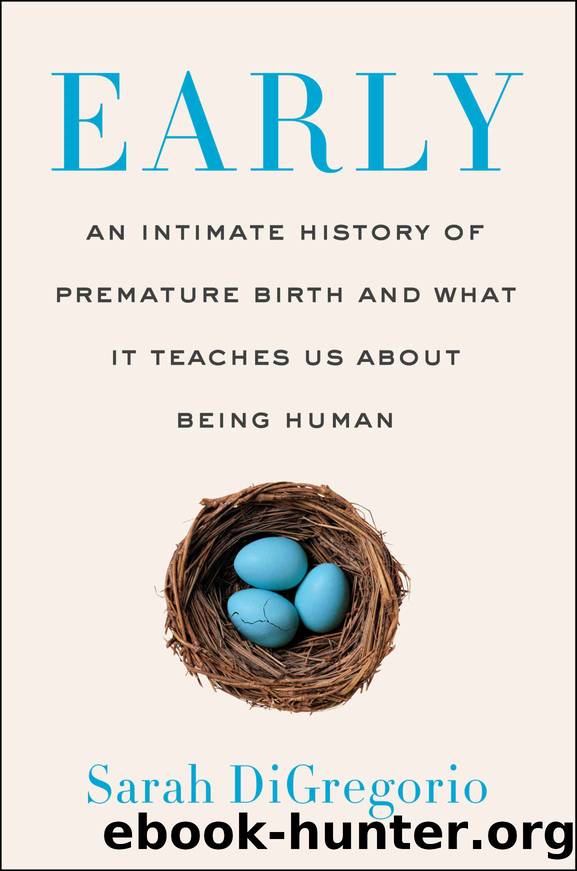Early by Sarah DiGregorio

Author:Sarah DiGregorio [DiGregorio, Sarah]
Language: eng
Format: azw3
Publisher: Harper
Published: 2020-01-27T16:00:00+00:00
13
Knowing When to Stop
DR. EDMUND LAGAMMA was sitting shoulder to shoulder with a young father; in front of them was a baby in an incubator, and arrayed around the incubator were an oscillator ventilator and several IV pumps and monitors. It was enough medical technology to fill a sedan. The baby herself was obscured under the tubes and wires; her small arms waved in the air, movements that at first glance looked typical. But her arms were jerky and stiff, and the longer I watched, the more obvious it was that something was wrong. “See,” said LaGamma. “I think she’s seizing.”
A nurse practitioner hurried out of the room, silent tears streaming down her face. The father put his head in his hands and then he turned to LaGamma. “I know it’s bad,” he said. “I understand. But, please, can you just put a needle in and take the blood out of her brain?” And LaGamma began to explain again, for the fourth time in a half hour, that the bleeding in this baby’s brain was the result of an asphyxia, lack of oxygen, at birth. She had had multiple strokes at birth and her brain was damaged; no one had a cure for this. He offered the father two choices: keep her on life support or let her go.
The air in the room was thick. I was standing in a corner, trying to be invisible. My agreement with the hospital—that I could observe and report in the NICU as long as I didn’t disclose patient names or identifying information—suddenly seemed thin and vaguely shameful against the enormity of what I was witnessing. There were other babies in the room, which had space for six incubators. The room was one of several that make up the NICU at Maria Fareri Children’s Hospital in Valhalla, Westchester County, New York. A few nurses sat quietly, watching other monitors, and one mother was doing kangaroo care behind a curtain, holding her baby to her bare chest. And there was this father, sitting in an ordinary hospital chair, trying to understand what LaGamma was saying and coming up against the brick wall of his own sorrow. They circled around and around: “Please take the blood out of her brain.” “I can’t take the blood out of her brain.” His daughter was alive. If he allowed the doctors to withdraw life support, his daughter would die.
LaGamma, chief neonatologist at the hospital, felt that the kindest thing to do for this baby was to take her off the ventilator. He believes in trial of therapy and will recommend NICU care for 23-week babies and others who have long odds, like this baby girl, who was only a few weeks early but suffered a catastrophic complication at birth. The trial-of-therapy approach, by definition, necessitates a willingness to consider withdrawing life support later, if that treatment is likely only prolonging the dying.
LaGamma was careful to present both choices, but he also made it obvious what he thought: There was no effective treatment for this baby.
Download
This site does not store any files on its server. We only index and link to content provided by other sites. Please contact the content providers to delete copyright contents if any and email us, we'll remove relevant links or contents immediately.
| Breast Cancer | Candida |
| Chronic Fatigue Syndrome & Fibromyalgia | Endometriosis |
| General | Lupus |
| Menopause | Menstruation |
| Postpartum Depression | Pregnancy & Childbirth |
| Sexual Health |
Name Book, The: Over 10,000 Names--Their Meanings, Origins, and Spiritual Significance by Astoria Dorothy(2490)
Tone Your Tummy Type by Denise Austin(2368)
The Women's Health Fitness Fix by Jen Ator(1925)
The Expectant Father by Armin A. Brott & Jennifer Ash(1894)
The Coregasm Workout by Debby Herbenick(1819)
The Ultimate Guide to Anal Sex for Women by Tristan Taormino(1752)
Expecting Better by Emily Oster(1706)
She-ology by Sherry A. Ross MD(1697)
The Hite Report on Shere Hite by Shere Hite(1661)
8 Steps to Reverse Your PCOS by Fiona McCulloch(1595)
Woman: An Intimate Geography by Natalie Angier(1583)
Birth by Tina Cassidy(1571)
Women & the Weight Loss Tamasha by Diwekar Rujuta(1525)
The Female Brain by M.D. Louann Brizendine(1515)
101 Get-Lean Workouts and Strategies by Muscle & Fitness(1506)
50 Ways to Soothe Yourself Without Food by Susan Albers(1399)
The Big Booty Blueprint: Your Guide To A Bigger Butt In Less Than 12 Weeks by Bella Rahbek & Brandon Carter(1367)
Unleash the Power of the Female Brain: Supercharging Yours for Better Health, Energy, Mood, Focus, and Sex by Daniel G. Amen M.D(1285)
The overachievers by Robbins Alexandra(1284)
